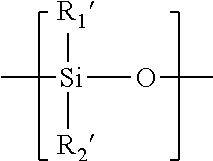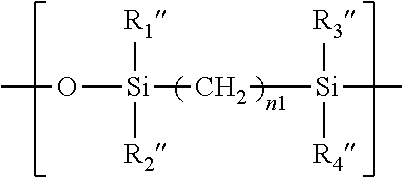Process for producing contact lenses with durable lubricious coatings thereon
a technology of contact lenses and coatings, which is applied in the field can solve the problems of insufficient thickness and durability of lbl coatings, ineffective plasma treatment of silicone hydrogel contact lenses, and insufficient thickness of lbl coatings
- Summary
- Abstract
- Description
- Claims
- Application Information
AI Technical Summary
Benefits of technology
Problems solved by technology
Method used
Image
Examples
example 1
Manually Rubbing Tests
[0182]The lenses are manually rubbed according to product insert with RENU® multi-purpose lens care solution (or another multi-purpose lens care solution) for 20 seconds and placed back to the lens case containing fresh lens care solution. The above procedure is repeated for a given times, e.g., from 1 to 30 times, (i.e., number of repetitions of manually rubbing tests which imitate cleaning and soaking cycles). As used in this application, the term “ix cycles” (e.g., 7× cycled) means i times of manual rubbing (e.g., 7 times) of repetitions of manual rubbing tests described above for imitating cleaning and soaking cycles.
Lubricity Evaluation.
[0183]The lubricity of a lens is evaluated by using a finger-felt lubricity test which characterizes qualitatively the slipperiness of a lens surface on a friction rating scale of from 0 to 4. The higher the friction rating is, the lower the slipperiness (or lubricity).
[0184]Commercial lenses: DAILIES® TOTAL1®; ACUVUE® OASY...
example 2
[0188]Unless otherwise stated, all chemicals are used as received.
Synthesis of Macromer
[0189]51.5 g (50 mmol) of the perfluoropolyether Fomblin® ZDOL (from Ausimont S.p.A, Milan) having a mean molecular weight of 1030 g / mol and containing 1.96 meq / g of hydroxyl groups according to end-group titration is introduced into a three-neck flask together with 50 mg of dibutyltin dilaurate. The flask contents are evacuated to about 20 mbar with stirring and subsequently decompressed with argon. This operation is repeated twice. 22.2 g (0.1 mol) of freshly distilled isophorone diisocyanate kept under argon are subsequently added in a counterstream of argon. The temperature in the flask is kept below 30° C. by cooling with a waterbath. After stirring overnight at room temperature, the reaction is complete. Isocyanate titration gives an NCO content of 1.40 meq / g (theory: 1.35 meq / g).
[0190]202 g of the α,ω-hydroxypropyl-terminated polydimethylsiloxane KF-6001 from Shin-Etsu having a mean molecul...
example 3
[0194]This example describes the procedures for preparing solutions, dip coating, and in-package-crosslinking coating in each Example below. The plasma-coated silicone hydrogel (SiHy) contact lenses prepared in Example 2 are used in each example below.
PMAA Solution
[0195]Aqueous solutions of polymethyacrylic acid (PMAA) are prepared by dissolving an adequate amount of PMAA (Mw˜1316K Daltons) in water (distilled or deionized water) and by adding an adequate amount of formic acid to adjust the solution pH to about 2.3 to about 2.8. The PMAA solution is heated to a temperature above room temperature, for example 40° C., when being used in the PMAA dip coating process.
Phosphate Buffer (PB) A phosphate buffer (PB) is prepared by dissolving NaH2PO4.H2O and Na2HPO4.2H2O in a given volume of purified water (distilled or deionized) to have about 0.044 w / w % of NaH2PO4.H2O and about 0.388 w / w / % of Na2HPO4.2H2O.
[0196]A phosphate buffer (PB) is prepared by dissolving...
PUM
| Property | Measurement | Unit |
|---|---|---|
| Temperature | aaaaa | aaaaa |
| Temperature | aaaaa | aaaaa |
| Temperature | aaaaa | aaaaa |
Abstract
Description
Claims
Application Information
 Login to View More
Login to View More - R&D
- Intellectual Property
- Life Sciences
- Materials
- Tech Scout
- Unparalleled Data Quality
- Higher Quality Content
- 60% Fewer Hallucinations
Browse by: Latest US Patents, China's latest patents, Technical Efficacy Thesaurus, Application Domain, Technology Topic, Popular Technical Reports.
© 2025 PatSnap. All rights reserved.Legal|Privacy policy|Modern Slavery Act Transparency Statement|Sitemap|About US| Contact US: help@patsnap.com



